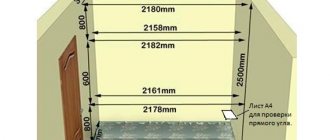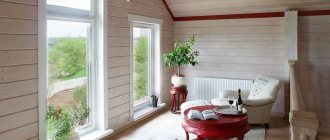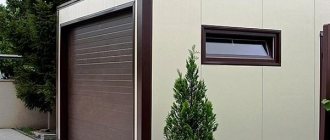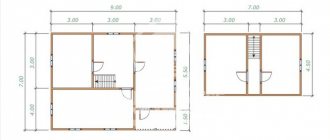A country house in Russia is more than just 4 walls. This is a place for a comfortable country holiday. And you can have a good rest only if you use all the opportunities, including outdoor recreation, in nature. That’s why proper arrangement of a patio is a must have for any country house.
Land development is a question that faces everyone who is planning to build or buy a country house. And the comfort and good mood of all residents and vacationers in your country residence depends on how well this issue is thought out.
So, how can you create a cozy and landscaped courtyard inside the site, where you could gather in the evening with family and friends for a barbecue, next to the fire pit, sitting on elegant rattan chairs? And is it possible to do this at minimal cost, with your own hands? Let's figure it out.
Stage 1. Preparation
First you need to decide on the location of your patio, as well as its area. Typically the area is 20-30 square meters. meters turns out to be quite enough.
As for the location, it all depends on the landscape of the area and your personal preferences. A courtyard located on a small hill (if there is one) or in the corner of the site will look especially good.
How to protect yourself on the street?
Author of the question: Gorshkov E. Created: 01/02/22
Follow simple tips for behavior on the street in the dark to avoid an attack: 1. Think about your evening route. Exclude from it roads that run through vacant lots, construction sites, industrial zones, parks, along long abandoned buildings, through passages under overpasses, deserted underground and overground pedestrian crossings, streets with noisy nightclubs and drinking establishments, unlit paths between houses.
Answered by: Nosov N. 01/03/22
Stage 2. Landscaping of the site next to the house
Arrangement of the yard begins from the site next to the house. As a rule, the area adjacent to the building is fenced off, leaving only one part of it (usually the southern part) open.
If the courtyard is adjacent to the front part of the house, then steps must be brought up to it from the street side. They can be decorated with flowers or decorative tiles. Do not forget also that if you decide to concrete the site, then drainage pipes must be laid under it.
Before paving the site, it is necessary to carry out preparatory work - creating a cushion for the tile material. Don't forget about drainage. The drainage device is usually made as follows:
- To do this, dig a trench about 10 cm deep;
- The bottom and sides of the resulting trench are covered with geotextiles, which will protect the base from roots. To strengthen the sides, curb tape is used;
- The dug hole is filled up to the soil level with crushed stone, pebbles or screenings;
- Then the tiles or stones of the shape you need are laid.
The interior space of the patio involves paving a certain part of it with tiles. The rest of the area can be landscaped. A beautiful border, which at the same time prevents the shedding of materials, will add additional attractiveness to the areas and paths in your yard.
Veranda with a roof by the pond
It turns out that it is not always possible to pass through a through tunnel without hindrance. In the solution of the American architectural studio JLF & Associates, Inc, one part of the passage opens to the garden, and on the other side there is a small pond. Having arranged a veranda with a roof, it was possible to combine the two parts of the building and organize an unusual recreation area.
Stage 3. Arrangement of garden paths
Experts advise starting to install garden paths with the shape of your site. As a rule, it is rectangular, having a ratio of 1:3 or 1:5.
This should be taken into account when planning paths so that they are as functional as possible, that is, one path should lead to as many focal points as possible, that is, destinations of your route. This can be a rock garden, flower beds, gazebos and other elements.
The width of the paths should be sufficient for the passage of a garden wheelbarrow. In this case, there is no need to look for the shortest distances, that is, to lay direct routes. One of the best options is a main path encircling the area and several dividing the area into sectors. Naturally, the path should correspond to the route you will take guests, showing the beauty and landscape design of your site. But they should not be made too complicated and tortuous either.
To create paths, it is absolutely not necessary to resort to the help of construction professionals; there are no secrets of skill here; you don’t have to hire a landscape designer, but do everything yourself, that is, for free. If you use some simple tips, you can make decorative paths yourself.
In order to create a sidewalk path with your own hands, you need, even before completing your plan, to determine some aspects that will be related:
- with the terrain features of the site;
- with the general style of the territory, features of architectural design;
- with requirements for paths that will take into account the greatest load, operating conditions, etc.;
- with the peculiarities of the local climate and soil characteristics on the site;
- with the necessary amount that will be needed to install the tracks.
Taking into account all these aspects, it will be clear what material to use, how and where to place the tracks.
What to pave with?
It is advisable to divide paths in the garden according to their functional purpose. For example:
- Concrete paths can be made in places where you will ride a bicycle or carry a loaded wheelbarrow;
- places for walking and paths for certain seasons can be made using decorative materials that are less resistant to stress. For example, in the area around a pond or individual broken flower beds, you can lay out stone paths with your own hands. Such paths will become a unique decoration for any countryside and garden area.
It is likely that one of the paths should be permanent, designed for the movement of motor vehicles. Accordingly, when planning what your courtyard should ultimately turn into, you need to determine the location for the main road. The material used is asphalt or gravel. A more elegant solution would be decorative stone, paving slabs or geogrid.
For the remaining pedestrian paths, less capital materials can be used. The cheapest solutions are paths made of sand, gravel or brick chips. But keep in mind that sand is prone to washing out and requires annual renewal, and crumbs and gravel are unpleasant when walking barefoot.
More durable solutions include bricks laid flat or on edge. However, this material is quite fragile. The concrete from which walkways with a poured base are made is stronger.
To construct such a path, a drainage layer of sand about 5 cm thick is required. The base itself is reinforced to avoid breaks, or thermal joints are installed every 1.5 - 2 meters. Reinforcement is the best option, as it eliminates the rise of slabs due to spring subsidence of the soil. For reinforcement, a rod with a diameter of 5 to 8 mm or a mesh measuring 0.5 by 2 meters is required. The reinforcement needs to be laid on supports, for which you can use fragments of bricks.
Landscaping the yard of a private house
After the space has been demarcated, and paths and functional places have been designated, landscaping should be done.
During this process, you need to choose the correct location of the plants, taking into account their size and flowering time. Initially, you need to place trees and large shrubs. It is better to plant the most spectacular and original plants separately, thus focusing attention on them, highlighting these elements from the gray mass. Under one of the large trees you can install a small bench or circular bench
Flowers of bright colors are often used for landscaping. From plant colonies you can create unique monochromatic or multi-colored canvases and flower beds. When planting flowers, you need to know their flowering period so that a single picture is created that can please the eye all year round.
If you are too lazy to constantly mow the lawn, then you can place flowerpots with various plants in the yard. In winter they will be put away in a warm room, and in the spring they will be taken outside again. By doing this, you can grow a heat-loving plant on your site: tangerine, lemon, cypress, and so on. You can also decorate the flowerbed with vegetables and berries.
Finally, the almost finished private courtyard is decorated with decorative elements, sculptures, fountains and other tempting things.
Stage 4. Laying the patio cover
So, the boundaries of the patio have already been finally determined, the material for laying has been selected, and the top layer of turf has been removed. The area is ready for leveling.
Before you start laying any kind of covering, you should take care of organizing drainage throughout the entire area of the courtyard. If your choice fell on tiles, then when laying them, maintain at least a slight slope towards the drainage ditch.
It is advisable to start laying tiles from the highest place on your site. Drainage ditches should already be equipped and located in the lowest parts of the yard. They can be well camouflaged with beautiful borders or bushes.
First, the foundation is filled, after which it is compacted strictly along the exposed beacons. After organizing the base, a layer of mortar for laying slabs is poured onto it in the required quantity. The concrete solution is leveled with a board, after which the tiles are laid directly. The width of the seam when laying should be about 1.2 cm.
The most durable and durable material is clinker, which is a brick that has undergone additional heat treatment. Paving slabs are also popular solutions. Thanks to the huge variety of colors and shapes, you can freely choose exactly the tile that will best decorate the landscape design of your garden. And finally, if you like the atmosphere of the Middle Ages, then you can use paving stones.
Paths and platforms made of concrete will be optimal in almost any conditions. Resistance to sudden changes in temperature and moisture, and in addition, the ability to withstand severe loads depends on proper installation. You don't have to be a construction professional to do this. It will be enough to know the basic requirements for the process of creating concrete paths, which consist of:
- digging a trench up to 15 cm deep for a future path and installing formwork made of wood or plastic;
- preparing the base: compacting and placing a sand or gravel cushion;
- pouring concrete.
To prevent cracks from forming in the canvas, you must follow some rules. To prevent the base from absorbing moisture from the solution, it is necessary to slightly moisten it. Poured concrete, previously covered with a tarpaulin, should be periodically moistened in places of intense exposure to the sun's rays.
The last stage of path construction is their decoration. If, along with functionality, you want to give the paths an aesthetic appearance, decorate them with your own hands to your taste in accordance with the general style of the area.
For example, you can use paving slabs, granite slabs or artificial stone. You can also lay a mosaic of tile fragments on the concrete or frame the path from natural stones of unusual shapes and colors. You can also lay out solid paths from natural stone along the entire length of the site, which will always look harmonious in any landscape.
It is important that in addition to their beauty, platforms and sidewalk paths can withstand the necessary loads and serve you for many years, thanks to their resistance to adverse environmental influences.
Stage 5. Fencing the patio
Fencing is an important component of the patio, so the construction of such a fence must be approached thoroughly. It is important to consider that the fence must perform not only its main function, but also a decorative one.
It is better not to build a fence for the courtyard from heavy materials such as concrete slabs or bricks. Decorative fencing should be breathable and lightweight, not monumental and forbidding. A good material for fencing a patio is a picket fence made from thin boards. In some cases, thin brushwood can also be used.
If you use wicker material when building a fence, then it is better to paint all its elements in the same color as the material itself. This way you will maintain a uniform color scheme, and your fence will not look tacky.
Don't forget about an overhead cover for your patio that can protect you from the elements. Such a shelter can be made from awnings. You can also use awnings, wooden pergolas or umbrellas. The third option is vertical gardening of the yard using climbing plants. However, use all methods wisely - it is not recommended to completely cover the entire space of the courtyard.
Features of winter garden projects in the house
The winter garden has the appearance of a transparent structure that can visually expand the boundaries of a given room. The glass structure is equipped with an additional heating system in winter, ventilation and watering of plants. The simplicity of the construction contributes to the arrangement of even a balcony in a city apartment.
In a private house, you can make a winter garden in the attic or organize it on a glazed and insulated veranda if the house is one-story.
Special glass is special energy-saving double glazed windows. They consist of two or three glasses, inside of which there is an air cushion that saves heat inside the attic.
Double-glazed windows not only save you in winter, but also help in summer. In summer, they prevent the room from heating up too much, which has a positive effect on plants and people. The sun's rays penetrating into the glass greenhouse contribute to the creation of a greenhouse effect. This effect is used for the growth of vegetation indoors.
You will find all the information about the types of siding for cladding a house.
The presence of a heating system is not a mandatory element, because its main purpose is to create a microclimate and a certain temperature. If the attic is constructed of double or triple glass, then heating is often not required.
But, when building an extension from single glass, the presence of a system is mandatory so that the flora does not freeze in winter, because some plants do not survive at temperatures below +15 degrees.
A single-glazed attic must be equipped with an additional shading device. The dimmer is designed to prevent the room from overheating above +30 degrees, which will negatively affect their growth or even kill them.
Creating a sealed room is an important point, because cracks can allow cold air to penetrate into the extension
Having an automatic watering system is optional, but it is important to water almost daily. An automatic watering system will make human work easier
It is also necessary to provide a lighting system.
In winter, the sun does not always shine often, and the days are short at this time of year. Therefore, it is necessary to have additional lighting - artificial. These are the main features of arranging a house with a winter garden
It is also important to provide for the availability of auxiliary equipment for plant development











